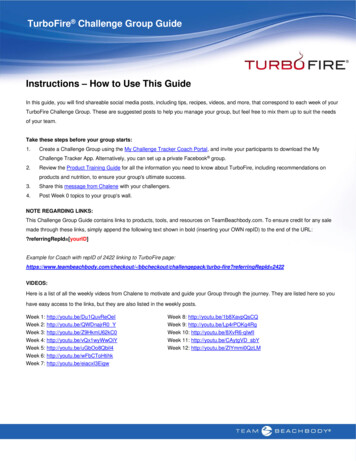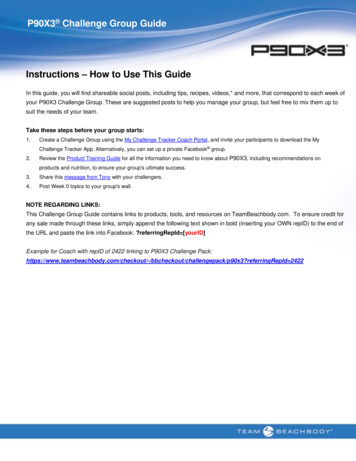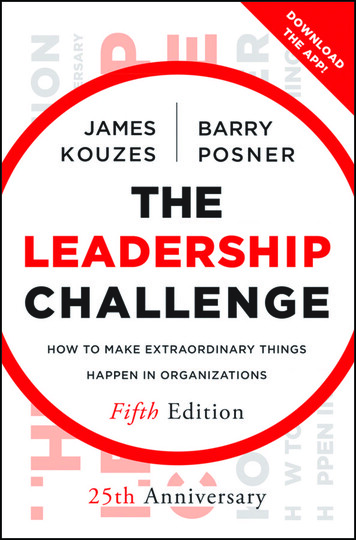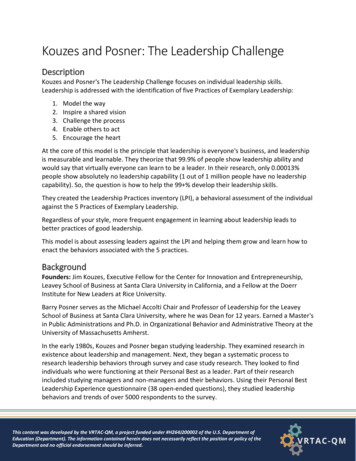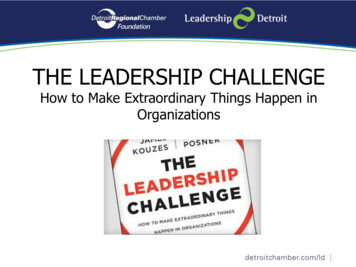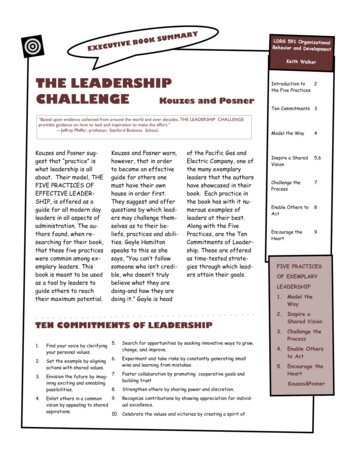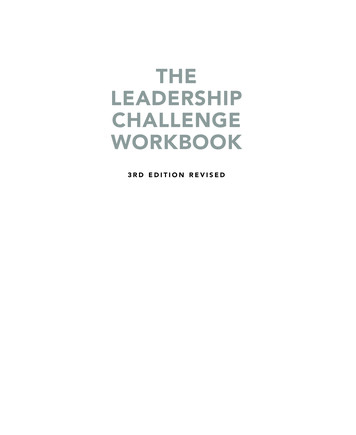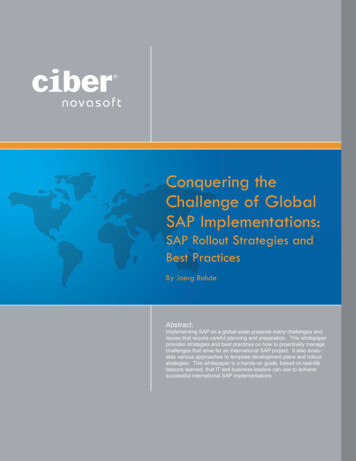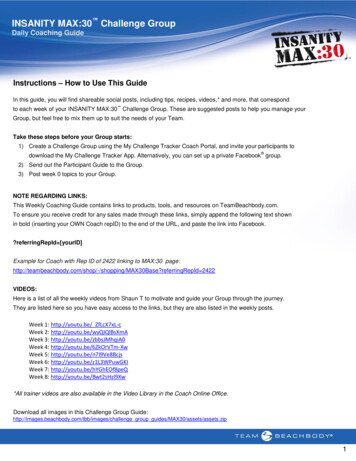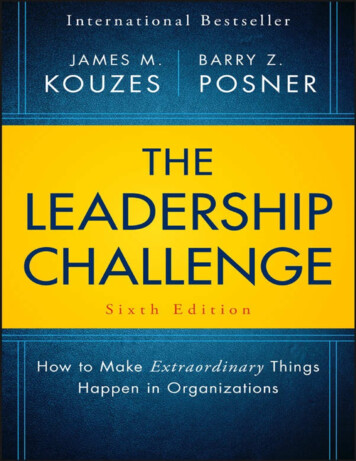
Transcription
ContentsCoverPraise for The Leadership Challenge, Sixth EditionTitle PageCopyrightIntroduction: Making Extraordinary Things Happen in OrganizationsWhat Leaders Do and What Constituents ExpectChapter 1: When Leaders Are at Their BestThe Five Practices of Exemplary Leadership The Five Practices Make a DifferenceThe Ten Commitments of Exemplary LeadershipNotesChapter 2: Credibility Is the Foundation of LeadershipWhat People Look for and Admire in Their LeadersPutting It All Together: Credibility Is the FoundationNotesPractice 1: Model the WayChapter 3: Clarify ValuesFind Your VoiceAffirm Shared ValuesNotesChapter 4: Set the ExampleLive the Shared ValuesTeach Others to Model the ValuesNotesPractice 2: Inspire a Shared VisionChapter 5: Envision the FutureImagine the PossibilitiesFind a Common Purpose
NotesChapter 6: Enlist OthersAppeal to Common IdealsAnimate the VisionNotesPractice 3: Challenge the ProcessChapter 7: Search for OpportunitiesSeize the InitiativeExercise OutsightNotesChapter 8: Experiment and Take RisksGenerate Small WinsLearn from ExperienceNotesPractice 4: Enable Others to ActChapter 9: Foster CollaborationCreate a Climate of TrustFacilitate RelationshipsNotesChapter 10: Strengthen OthersEnhance Self-DeterminationDevelop Competence and ConfidenceNotesPractice 5: Encourage the HeartChapter 11: Recognize ContributionsExpect the BestPersonalize RecognitionNotesChapter 12: Celebrate the Values and VictoriesCreate a Spirit of Community
Be Personally InvolvedNotesChapter 13: Leadership Is Everyone's BusinessExemplary Leadership Is LocalExemplary Leadership MattersLearning Leadership Takes PracticeContrasts and ContradictionsFirst Lead YourselfLeading Is DoingRemember the Secret to Success in LifeNotesAcknowledgmentsAbout the AuthorsIndexEnd User License Agreement
List of TablesTable 1.1Table 2.1Table 2.2Table 4.1Table 13.1
List of IllustrationsFigure 1.1Figure 3.1Figure 4.1Figure 5.1Figure 6.1Figure 7.1Figure 7.2Figure 8.1Figure 8.2Figure 9.1Figure 10.1Figure 10.2Figure 11.1Figure 12.1Figure 13.1
Praise for The Leadership Challenge, SixthEdition“Now in its sixth edition, The Leadership Challenge has stood the test of timefor good reason—it's quite simply one of the best books you'll ever read onleadership. A must read!”—Ken Blanchard, coauthor of The New One Minute Manager and Leading at a Higher Level“How can a book celebrate its 30th anniversary and still remain relevant? Easy!It's because the authors never stop growing, learning from all the clients theywork with, from all they read in the literature, and from one another. Theycontinue to fill the pages of this book with the best stories, examples, andmemorable lessons learned. This is the right resource for anyone just enteringthe leadership field, or for those who read the book three decades ago!”—Beverly Kaye, founder, Career Systems International,coauthor, Love 'Em or Lose 'Em, Help them Grow or Watch Them Go“Whether you are just beginning your leadership journey, or a seasoned CEO, ora professor of leadership, this timeless leadership classic needs to be withinconstant reach!”—Harry Kraemer Jr., former chairman and CEO, Baxter International;professor of management and strategy, Northwestern University's KelloggSchool of Management“The Leadership Challenge is a book that not only serves your career but moreimportantly it is a tool for leading a better life. Jim and Barry have put togetherone of the greatest of leadership insights. Every leader should take advantage ofthe gift that is The Leadership Challenge.”—Howard Behar, president (retired), Starbucks Coffee“I love The Leadership Challenge! This is the book on leadership that Irecommend to all of my clients. The sixth edition provides the best of all worlds:1. It contains the timeless wisdom that Jim and Barry have accumulated overmore than 25 years—it has been and continues to be a classic in our field. 2. Ithas been updated to reflect how their timeless leadership concepts can be bestapplied in today's ever-changing world.”
—Marshall Goldsmith, bestselling author of What Got You HereWon't Get You There, MOJO, and Triggers“I've been a fan—and follower—of The Leadership Challenge for almost 25years, and the principles are as relevant today as they have ever been. In thisleadership classic, Kouzes and Posner have identified and brought to lifeinvaluable practices that are as insightful as they are practical.”—Patrick Lencioni, president, The Table Group;bestselling author of The Five Dysfunctions of a Teamand The Advantage“No book has ever chronicled the practices of true leadership better than TheLeadership Challenge, and this updated edition deftly outlines how to be aphenomenal leader in the 21st century.”—Chip Conley, New York Times bestselling author of Emotional Equations,and Airbnb Global Head of Hospitality and Strategy“The Leadership Challenge is a classic, insightful and compelling book. Allleadership positions come with its own challenges, but not all leaders know howto navigate through them. If you are looking to excel as a leader, and you needdigestible and partial advice: The Leadership Challenge by Jim Kouzes andBarry Posner is the book for you. It will not only help you become a great aleader but it will help mobilize your people into getting extraordinary thingsdone. Buy this book, read this book and live this book. Then buy this book forthose who truly care about leadership.”—Lolly Daskal, president and founder of Lead From Within,author of The Leadership Gap: What Gets Between Youand Your Greatness“If I could recommend only one of the tens of thousands of leadership booksever written, The Leadership Challenge would absolutely be my top choice, andby a wide margin. This sixth edition builds markedly on the last but remainscharacteristically Jim Kouzes and Barry Posner—a complex work in itsunderlying character, but brilliant in its simplicity and practical in design. TheLeadership Challenge is the most useful leadership book ever written; I haveeach and every edition, and each is better than the last.”—Thomas A. Kolditz, PhD, director, Doerr Institute for New Leaders,Rice University“The Leadership Challenge is more relevant now than ever. Jim and Barry
continue to provide compelling evidence and examples of leadership thatembodies our humanity and capacity to intimately collaborate with others. Thisbook is important in sustaining our faith in the possibilities inherent ininstitutional life, no matter what chaos surrounds us at the moment. I highlyrecommend this book.”—Peter Block, author of Flawless Consulting and The Empowered Manager“Kouzes and Posner did not invent leadership but sometimes it seems that way.As Alice Waters is to cooking, or Paul McCartney is to music, Kouzes andPosner have developed a discipline and an approach to leadership that sets themapart from all the others. With the sixth edition of The Leadership Challengethey not only update their research, they make it once again, come alive. TheLeadership Challenge, 6th Edition, not only coaches us on how to makeextraordinary things happen, the book is extraordinary.”—Richard A. Moran, Ph.D., president, Menlo College andauthor of The Thing About Work, Showing Upand Other Important Matters“For over 25 years The Leadership Challenge has guided me to know myselfand growing as a leader and achieving better results—every time! This newedition improves on an already extraordinary and time tested model byemphasizing the importance and value of engaging your team and those aroundyou. In my business, being a better leader and growing new leaders meansimproving the health of people and their families. When nurses are moreengaged and authentically supported, patients are healthier! The LeadershipChallenge, with this contemporary update, enables me to improve the health ofpatients, their families and the communities that we serve. With so manyleadership books out there this is truly the ONLY one that you need.”—Lori Armstrong, MSN, RN, NEA-BC, chief nurse executive,Kaiser Permanente Santa Clara Medical Center“What appeals to me most about The Leadership Challenge, Sixth Edition issheer enthusiasm for the art and the practice of leadership. The art of leadershipinvolves bringing people together for common cause. The practice of leadershiprequires commitment to action for the common good. Both are easy to address,but hard to implement. In this wonderful new edition, Jim Kouzes and BarryPosner provide real-world advice—underscored with solid research—that pointsus in the right direction. Good stuff!”—John Baldoni, president, Baldoni Consulting LLC;
author, Lead with Purpose, Lead Your Boss, and Lead By Example“The Leadership Challenge is written for leaders who want to transformorganizations through some of the most turbulent times in healthcare. These casestudies and research on The Five Practices and Ten Commitments of Leadershippresent very practical ways to be visionary, innovative, collaborative, andengaged with your employees. Every nurse is a leader—from the bedside to theboardroom—and all should be competent in the works of The LeadershipChallenge. I recommend it to ALL!”—Susan Herman, DNP, MSN, RN, NEA-BC, CENP,2015 president, Assoc. of CA Nurse Leaders,and VP Patient Care Services & CNO,San Joaquin Community Hospital/Adventist Health“If I could recommend only one of the tens of thousands of leadership booksever written, The Leadership Challenge would absolutely be my top choice, andby a wide margin. This sixth edition builds markedly on the last but remainscharacteristically Jim Kouzes and Barry Posner—a complex work in itsunderlying character, but brilliant in its simplicity and practical in design. TheLeadership Challenge is the most useful leadership book ever written; I haveeach and every edition, and each is better than the last.”—Thomas A. Kolditz, PhD, director, Doerr Institute for New Leaders,Rice University“The Leadership Challenge isn't theory. It's insight based on rigorous andextensive research. And for me, the most profound insight is a very simple one:the importance of defining your own personal values and aligning yourleadership style around them. As the leader of a large sales organization, I'veseen firsthand how powerful that type of authentic leadership can be at alllevels.”—Mark Madgett, SVP & Head of Agency, New York Life
The Leadership ChallengeSixth Edition
How to Make Extraordinary Things Happen inOrganizationsJames M. KouzesBarry Z. Posner
Cover image: alzajac/iStockphotoCover design: WileyThis book is printed on acid-free paper.Copyright 2017 by James M. Kouzes and Barry Z. Posner. All rights reserved.Published by John Wiley & Sons, Inc., Hoboken, New Jersey.Published simultaneously in Canada.No part of this publication may be reproduced, stored in a retrieval system, or transmitted in any form or byany means, electronic, mechanical, photocopying, recording, scanning, or otherwise, except as permittedunder Section 107 or 108 of the 1976 United States Copyright Act, without either the prior writtenpermission of the Publisher, or authorization through payment of the appropriate per-copy fee to theCopyright Clearance Center, 222 Rosewood Drive, Danvers, MA 01923, (978) 750-8400, fax (978) 6468600, or on the web at www.copyright.com. Requests to the Publisher for permission should be addressedto the Permissions Department, John Wiley & Sons, Inc., 111 River Street, Hoboken, NJ 07030, (201) 7486011, fax (201) 748-6008, or online at www.wiley.com/go/permissions.Limit of Liability/Disclaimer of Warranty: While the publisher and author have used their best efforts inpreparing this book, they make no representations or warranties with the respect to the accuracy orcompleteness of the contents of this book and specifically disclaim any implied warranties ofmerchantability or fitness for a particular purpose. No warranty may be created or extended by salesrepresentatives or written sales materials. The advice and strategies contained herein may not be suitable foryour situation. You should consult with a professional where appropriate. Neither the publisher nor theauthor shall be liable for damages arising herefrom.For general information about our other products and services, please contact our Customer CareDepartment within the United States at (800) 762-2974, outside the United States at (317) 572-3993 or fax(317) 572-4002.Wiley publishes in a variety of print and electronic formats and by print-on-demand. Some materialincluded with standard print versions of this book may not be included in e-books or in print-on-demand. Ifthis book refers to media such as a CD or DVD that is not included in the version you purchased, you maydownload this material at http://booksupport.wiley.com. For more information about Wiley products, visitwww.wiley.com.Library of Congress Cataloging-in-Publication Data has been applied for and is on file with theLibrary of Congress.978-1-119-27896-2 (hardback) 978-1-119-27898-6 (ePDF) 978-1-119-27897-9 (ePUB)
IntroductionMaking Extraordinary Things Happen inOrganizationsThe Leadership Challenge is about how leaders mobilize others to want to getextraordinary things done in organizations. It's about the practices leaders use totransform values into actions, visions into realities, obstacles into innovations,separateness into solidarity, and risks into rewards. It's about leadership thatmakes a positive difference in the workplace and creates the climate in whichpeople turn challenging opportunities into remarkable successes.The publication of this edition of The Leadership Challenge marks thirty yearssince the book was first published. We've spent nearly four decades togetherresearching, consulting, teaching, and writing about what leaders do when theyare at their best and how everyone can learn to become better leaders. We'rehonored by the reception we've received in the professional and businessmarketplace and blessed that students, educators, and practitioners continue tofind that The Leadership Challenge is both conceptually and practically useful.We persist in asking today the same basic question we asked in 1982 when westarted our journey into understanding exemplary leadership: What did you dowhen you were at your personal best as a leader? We've talked to men andwomen, young and old, representing just about every type of organization thereis, at all levels, in all functions, from many different places around the world.Their stories, and the behaviors and actions they've described, have resulted inthe creation of The Five Practices of Exemplary Leadership frameworkdescribed in this book. When leaders do their best, they Model the Way, Inspirea Shared Vision, Challenge the Process, Enable Others to Act, and Encouragethe Heart.The Leadership Challenge is evidence-based. Analyzing thousands of casestudies and millions of survey responses resulted in The Five Practicesframework. The hundreds of examples in this book, of real people doing realthings, document the practical nature of the model. Each chapter provides freshand original data on the impact that the behavior of leaders has on engagementand performance.With each new edition, we get clearer about the leadership actions that make adifference. We reiterate what's still important, discard what's not, and add what'snew. We contemporize the framework and freshen up the language and point of
new. We contemporize the framework and freshen up the language and point ofview so that the book is highly relevant to current circumstances and conditions.And, we are more authoritatively prescriptive about the best practices of leaders.The more we research and write about leadership, the more confident webecome that leadership is within the grasp of everyone. The opportunities forleadership are boundless and boundaryless.With each new edition, we also get to address a new audience, and sometimeseven a new generation of emerging leaders. That opportunity motivates us tocollect new cases, examine new research findings, and talk with people wehaven't heard from. It encourages us to perform a litmus test of relevance on ourresults: Does this model of leadership continue to make sense? If we started allover again, would we find new leadership practices? Would we eliminate any ofthe practices? In this regard, we are aided by the ongoing empirical dataprovided by the online version of the Leadership Practices Inventory. Thisinventory, which assesses The Five Practices, provides more than 400,000responses annually, and keeps us on guard and on target in identifying thebehaviors that make a difference.We know that all of you face vexing issues that not only make leadership moreurgent, but also require you to be more conscious and conscientious about beinga leader. Others are looking to you to help them figure out what they should bedoing and how they can develop themselves to be leaders. You don't just owe itto yourself to become the best leader you can possibly be. You owe it to yourconstituents. They are also expecting you to do your best.
A Field Guide for LeadersHow do you become the kind of leader people want to follow? How do you getother people, by free will and free choice, to move forward together in pursuit ofa common vision? How do you mobilize others to want to struggle for sharedaspirations? These are only some of the important questions we address in TheLeadership Challenge. Think of the book as a field guide to take along on yourleadership journey. Think of it as a manual you can consult when you wantadvice and counsel on how to make things happen and move forward.Chapter One offers two case studies about Personal-Best LeadershipExperiences. These stories took place in dissimilar locations and industries,involving different functions, people, and styles, but they both illustrate how TheFive Practices apply whenever you accept the challenge of leadership. Thechapter continues with an overview of The Five Practices and illustratesempirically that these leadership practices make a difference.Asking leaders about their personal bests is important, but it's only half the story.Leadership is a relationship between leaders and followers. A more completepicture of leadership develops when you understand what people look for insomeone they would willingly follow. In Chapter Two, we reveal thecharacteristics people value most in their leaders and share the voices of peopleexplaining why these are important.The ten chapters that follow describe the Ten Commitments of Leadership—theessential behaviors that leaders employ to make extraordinary things happen—and explain the conceptual principles that support each of The Five Practices.We offer evidence from our research, and that of others, to support theprinciples, provide examples of real people who demonstrate each practice inreal life, and prescribe specific recommendations on what you can do to makeeach practice your own. A Take Action section concludes each of these chapters,suggesting what you need to do to make this leadership practice an ongoing andnatural part of your behavioral and attitudinal repertoire. Whether the focus isyour own learning or the development of your constituents—your direct reports,team, peers, manager, community members, and the like—you can takeimmediate action on every one of our recommendations. They don't require abudget or approval from anyone. They just require your personal commitmentand discipline.In Chapter Thirteen, we call on everyone to accept personal responsibility to be arole model for leadership. Through six editions, we continue to champion the
role model for leadership. Through six editions, we continue to champion theview that leadership is everyone's business. The first place to look for leadershipis within yourself. Accepting the leadership challenge requires reflection,practice, humility, and taking advantage of every opportunity to make adifference. As we have in every edition, we close with this conclusion:Leadership is not an affair of the head. Leadership is an affair of the heart.We recommend that you first read Chapters One and Two, but after that there isno sacred order to proceeding through the rest of this book. Go wherever yourinterests are. We wrote this material to support you in your leadershipdevelopment. Just remember that each practice and commitment of leadership isessential. Although you might skip around in the book, you can't skip any of thefundamentals of leadership.The domain of leaders is the future. The work of leaders is change. The mostsignificant contribution leaders make is not to today's bottom line; it is to thelong-term development of people and institutions so they can adapt, change,prosper, and grow. Our ongoing aspiration is that this book contributes to therevitalization of organizations, to the creation of new enterprises, to the renewalof healthy communities, and to greater respect and understanding in the world.We also fervently hope that it enriches your life and that of your community andyour family.Leadership is important, not just in your career and within your organization, butin every sector, in every community, and in every country. We need moreexemplary leaders, and we need them more than ever. So much extraordinarywork needs to be done. We need leaders who can unite us and ignite us.Meeting the leadership challenge is a personal—and a daily—challenge foreveryone. We know that if you have the will and the way to lead, you can. Yousupply the will. We'll do our best to keep supplying the way.James M. KouzesOrinda, CaliforniaBarry Z. PosnerBerkeley, CaliforniaApril 2017
What Leaders Do and What Constituents Expect
Chapter 1When Leaders Are at Their BestFor Brian Alink, the digital revolution is as profound as the IndustrialRevolution.1 The way organizations solve problems, drive innovation, and scalethose innovations to millions of people so quickly and efficiently is massivelychanging the workplace, the marketplace, and the community. But as exciting asall this is, something else energizes him even more: the chance to learn how tobe an even more effective leader in this new context.2The opportunity to do just that came when Brian was asked to help refine howthe credit card business at Capital One Financial Corporation serviced customersacross all channels. This challenge was different from others he had spearheadedbecause it was about “how we change the mind-sets of leaders across the creditcard business to use a digital-first approach for servicing. It was about solvingreal problems that cause customers pain, anxiety, or frustration, and about howwe can make it better for them.”When Brian moved into his current role as managing vice president at CardDigital Channels, he began working with a newly formed team that had justcome together. “This put a whole lot of uncertainty into what we were doing,” heacknowledged, and so Brian spent the first few weeks meeting with theexecutives and other leaders who owned parts of the customer experience, “justlistening, learning, getting context, and immersing myself in the situation.” Hedid the same one-on-one with his immediate team. Guiding him in this initialrelationship-building process was a leadership philosophy that had served himwell over the years: “At the very beginning of a journey like this,” he said, “it'sabout getting to know each other personally.”It's about knowing who these people are that are working with me, knowingtheir values, what they love to do, what they care about, and what theystand for. I also love the opportunity to introduce myself—not as a leader oras a strategist or as the analyst or whatever we're trying to do—but just assomebody who is with them as a real human trying to have a greaterexperience in life and trying to make the world a better place.Brian pulled his entire leadership team together for a four-hour discussion. Hebegan by explaining how he was attempting to build an environment of trust:This is the kind of environment where we want to do the greatest work of
This is the kind of environment where we want to do the greatest work ofour lives, where we want to truly make a difference, where we're feelingcommitted and we want to do something that matters, that has meaning tous personally.Trust comes from understanding each other's values and understanding ourexperiences and what we stand for. In order for that to happen, we've got tobe vulnerable, and we have to be open. Then we can build on that base ofvalues and trust.Brian had found that every time he's had this conversation with a new team theexperience had been “magical.” Without exception, people opened up and sharedtheir personal challenges with one another. As Brian appreciates, everyone haschallenges in their lives, and that it's those hard moments that shape who peopleare and what they stand for. “What drives all of us,” Brian says, “is that we wantto do something meaningful for the people we work with, where it really helpsthem grow and do something better for the people around us. We want to havethat same kind of impact on our customers.”Through those early meetings, Brian and his team got clear about their sharedvision and values. They developed their core strategy and determined how theywere going to operate. With this collaborative effort, everyone on the team feltthey had created their approach together and developed ownership for it.Brian and his leadership team then designed and conducted an all-hands meetingthat included both his immediate team and extended teams outside the CardCustomer Experience organization. They walked everyone through the processtheir team had gone through together, then rolled out the new plan and engagedeveryone—the developers, the software engineers, the designers, and others—inlearning about their mission. This approach helped to dissipate much of theconcern and ambiguity, and, Brian observed, “communicated clearly that theleadership team was emotionally committed, had each other's backs, were hereto help support our entire team, and to do something big that really mattered.”But they didn't want this to be only a priority for the customer experience team.They needed to make the idea of helping customers become more digital, andhave effortless experiences, a shared vision across all of the credit card business.They wanted everyone—people from product design, credit policy, fraud,collection, credit lines, lost and stolen cards, and other functions—to seethemselves in the bigger picture. Brian's team set up meetings with leaders fromacross the business, shared their aspirations with them, showed them wherecustomers were running into problems, provided them with insightful data, andtold them how they could work together to create painless experiences for
told them how they could work together to create painless experiences forcustomers.As essential as it is to create a vision for and to serve your own vertical team,Brian told us, it's equally important to do the same for your peers and those youdon't directly manage:If we can get leaders who are adjacent to our area to come help us and thenbe willing to give them the credit for the help they provide, it doesn't takeaway from my leadership or my team's contribution at all. This is apowerful way to get a lot more intelligence and mind share and support forsomething bigger that we all need to be working on. In doing so, we createa win for everybody.Knowing that getting others to collaborate isn't always easy, Brian offeredtechnical resources from his own team in order to help others help him. Heoperated on a compelling premise: “We are going to win if we help others win.We've got to give in order to get. If we can move the whole organization, whatwe are going to get is so much bigger than what we could ever have done on ourown. . . . Being humble and letting others shine comes back to you many timesover.” Brian's team created moments when leaders from other parts of theorganization would come together and showcase their work. These forumselevated others, honored them, and gave them public recognition and credit forthe contributions they were making.While the core of the customer experience approach to leading is elevatingothers, staying in the background, and giving credit to others, Brian makes surethat those who do the giving are refueled with the energy they need to keep ongiving. Each week, he and his leadership team hold standup meetings at whichthey highlight what everyone is working on and look into problems, successes,lessons learned, and even failures they've had. Those who work in differentgeographic locations join by video. During these meetings, the leadership teamlooks for “praise moments” where they can draw attention to exemplarybehaviors in front of everyone. When they hear or see something they want toshine a spotlight on, someone will say, “Let's pause for just a moment. That rightthere was a wonderful example of what we are striving to do.” When people seethe successes and hear the positive feedback, it creates momentum.“When working to transform a company into a customer-focused, digitalorganization,” Brian told us, “it's immensely helpful to frame the leadershipscope as a mission that transcends organizational boundaries. Customers don'tknow which part of an organization they are dealing with! Limiting theleadership model to the immediate team greatly limits the scope and speed of
leadership model to the immediate team greatly limits the scope and speed ofimpact a leader can have on transforming a complex customer journey throughan organization.”This is definitely a leadership philosophy for a new era. It's a 360-degree view ofleadership that is more inclusive and more open than what many people haveexperienced in the past, and it produces results. In less than a year, thiscollaborative effort at Capital One improved a multitude of customerexperiences. For exam
“The Leadership Challenge is a classic, insightful and compelling book. All leadership positions come with its own challenges, but not all leaders know how to navigate through them. If you are looking to excel as a leader, and you need digestible and partial advice: The Leadership Challenge
